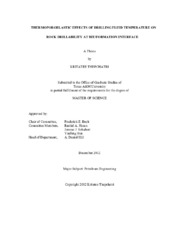| dc.contributor.advisor | Beck, Frederick E | |
| dc.creator | Thepchatri, Kritatee 1984- | |
| dc.date.accessioned | 2013-03-14T16:15:11Z | |
| dc.date.available | 2014-12-12T07:18:55Z | |
| dc.date.created | 2012-12 | |
| dc.date.issued | 2012-10-26 | |
| dc.date.submitted | December 2012 | |
| dc.identifier.uri | https://hdl.handle.net/1969.1/148164 | |
| dc.description.abstract | A drilling operation leads to thermal disturbances in the near-wellbore stress, which is an important cause of many undesired incidents in well drilling. A major cause of this thermal disturbance is the temperature difference between the drilling fluid and the downhole formation. It is critical for drilling engineers to understand this thermal impact to optimize their drilling plans.
This thesis develops a numerical model using partially coupled thermoporoelasticity to study the effects of the temperature difference between the drilling fluid and formation in a drilling operation. This study focuses on the thermal impacts at the bit/formation interface. The model applies the finite-difference method for the pore pressure and temperature solutions, and the finite-element method for the deformation and stress solutions. However, the model also provides the thermoporoelastic effects at the wellbore wall, which involves wellbore fractures and wellbore instability.
The simulation results show pronounced effects of the drilling fluid temperature on near-wellbore stresses. At the bottomhole area, a cool drilling fluid reduces the radial and tangential effective stresses in formation, whereas the vertical effective stress increases. The outcome is a possible enhancement in the drilling rate of the drill bit. At the wellbore wall, the cool drilling fluid reduces the vertical and tangential effective stresses but raises the radial effective stress. The result is a lower wellbore fracture gradient; however, it benefits formation stability and prevents wellbore collapse. Conversely, the simulation gives opposite induced stress results to the cooling cases when the drilling fluid is hotter than the formation. | en |
| dc.format.mimetype | application/pdf | |
| dc.subject | Better Rate of Penetration | en |
| dc.subject | Petroleum Geomechanics | en |
| dc.subject | Rock Mechanics | en |
| dc.subject | Rock Drillability | en |
| dc.subject | Drilling Fluid Temperature | en |
| dc.subject | Thermoporoelastic | en |
| dc.subject | Drilling | en |
| dc.subject | Petroleum | en |
| dc.title | Thermoporoelastic Effects of Drilling Fluid Temperature on Rock Drillability at Bit/Formation Interface | en |
| dc.type | Thesis | en |
| thesis.degree.department | Petroleum Engineering | en |
| thesis.degree.discipline | Petroleum Engineering | en |
| thesis.degree.grantor | Texas A&M University | en |
| thesis.degree.name | Master of Science | en |
| thesis.degree.level | Masters | en |
| dc.contributor.committeeMember | Hasan, Rashid A | |
| dc.contributor.committeeMember | Schubert, Jerome J | |
| dc.contributor.committeeMember | Sun, Yuefeng | |
| dc.type.material | text | en |
| dc.date.updated | 2013-03-14T16:15:11Z | |
| local.embargo.terms | 2014-12-01 | |


